Analysis of People Management Practices at Century Ltd Report
VerifiedAdded on 2021/02/21
|13
|3998
|55
Report
AI Summary
This report provides an in-depth analysis of people management practices within Century Ltd, a Dubai-based financial services and brokerage organization. The report is divided into three sections, covering communication, teamwork, and remote work. Section A examines the benefits of effective communication, policies and procedures to enhance communication, relevant legislation, the impact of organizational structure on communication methods, and the influence of new technologies on communication systems. Section B delves into the benefits of teamwork for individuals and organizations, reasons for team failures, the impact of leadership styles, and the application and effectiveness of teamwork within Century Ltd. Finally, Section C explores the implications of different remote work arrangements and common working practices used in remote contexts, along with support and monitoring structures. The report highlights the importance of effective communication, teamwork, and adapting to new technologies and working styles for organizational success.
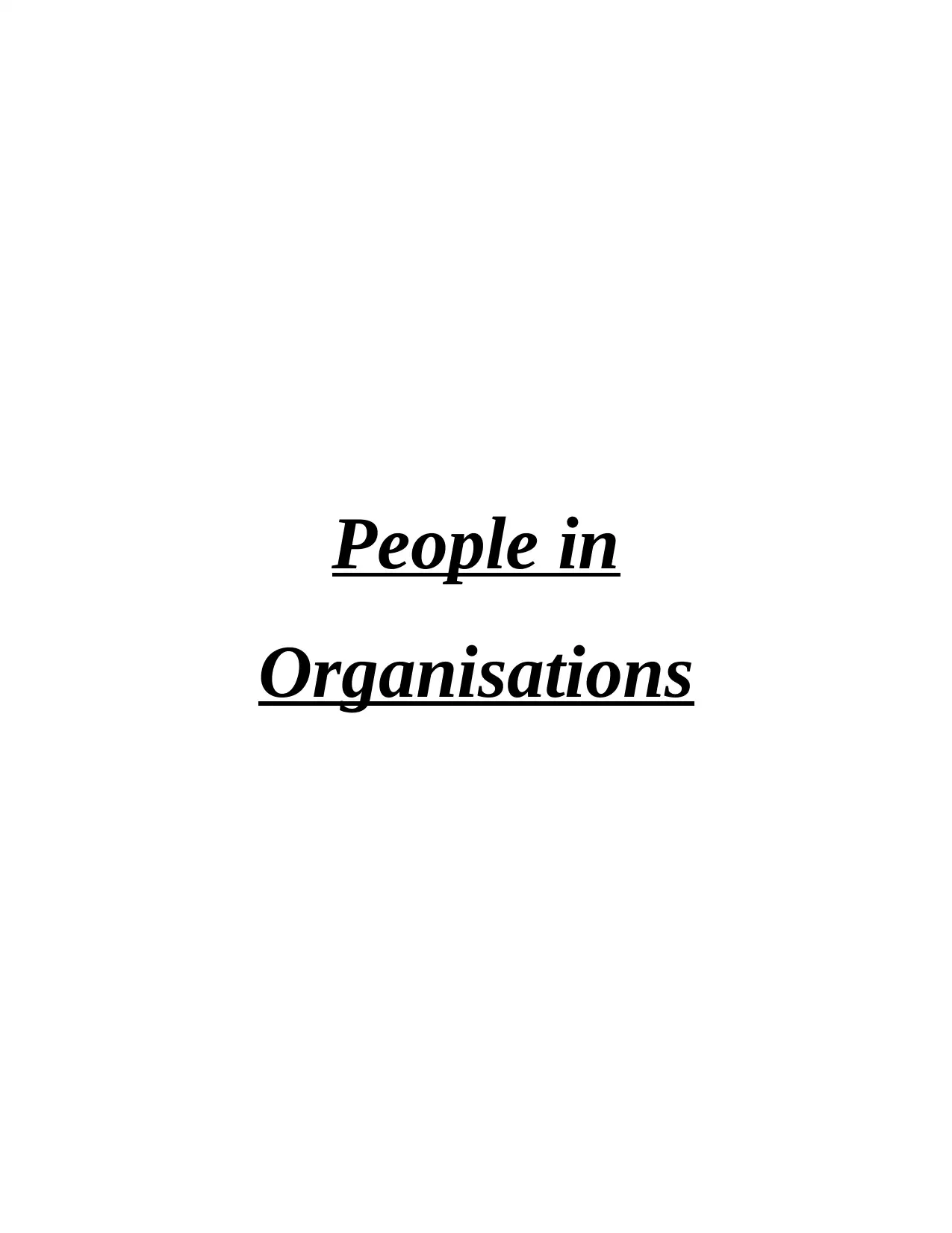
People in
Organisations
Organisations
Paraphrase This Document
Need a fresh take? Get an instant paraphrase of this document with our AI Paraphraser

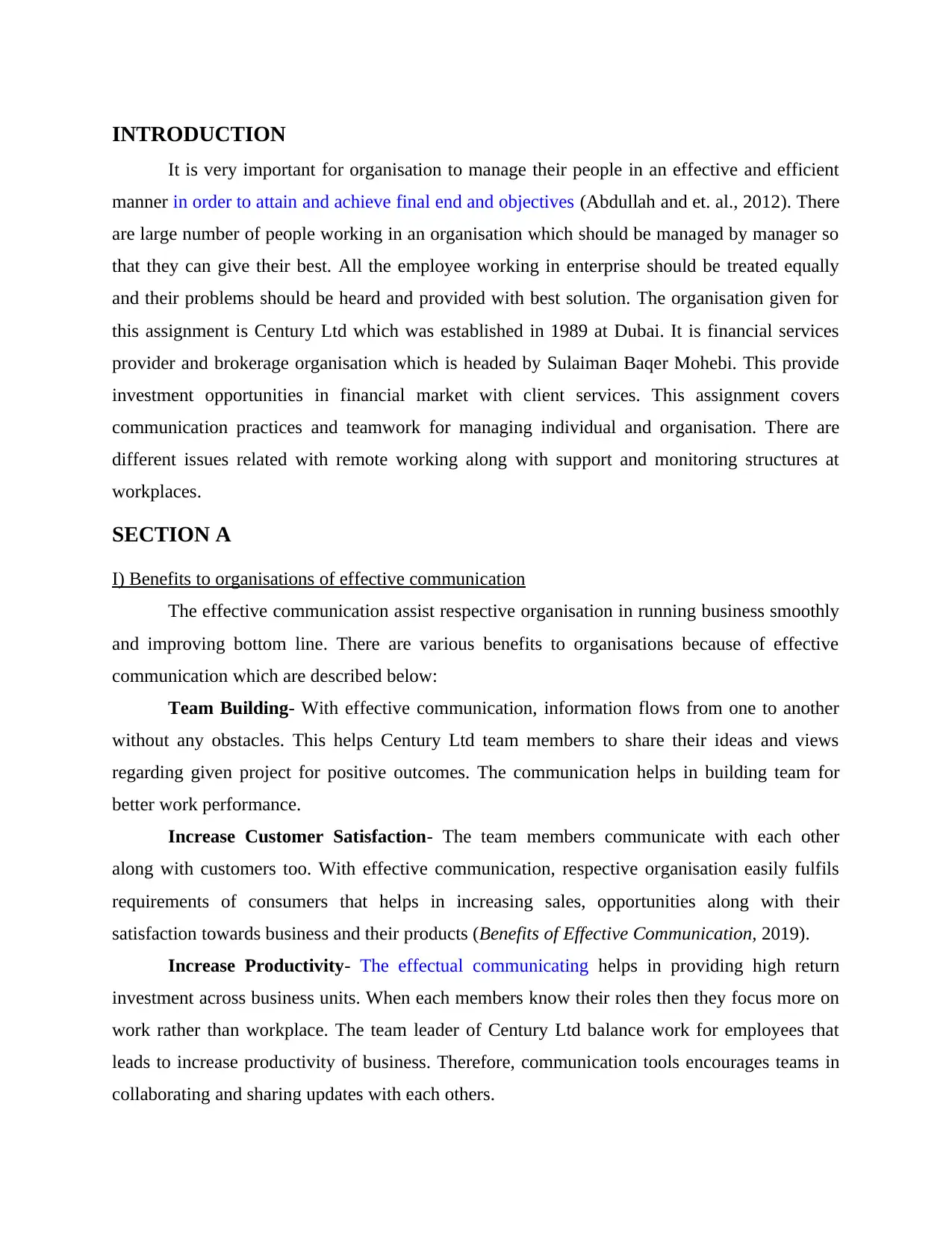
INTRODUCTION
It is very important for organisation to manage their people in an effective and efficient
manner in order to attain and achieve final end and objectives (Abdullah and et. al., 2012). There
are large number of people working in an organisation which should be managed by manager so
that they can give their best. All the employee working in enterprise should be treated equally
and their problems should be heard and provided with best solution. The organisation given for
this assignment is Century Ltd which was established in 1989 at Dubai. It is financial services
provider and brokerage organisation which is headed by Sulaiman Baqer Mohebi. This provide
investment opportunities in financial market with client services. This assignment covers
communication practices and teamwork for managing individual and organisation. There are
different issues related with remote working along with support and monitoring structures at
workplaces.
SECTION A
I) Benefits to organisations of effective communication
The effective communication assist respective organisation in running business smoothly
and improving bottom line. There are various benefits to organisations because of effective
communication which are described below:
Team Building- With effective communication, information flows from one to another
without any obstacles. This helps Century Ltd team members to share their ideas and views
regarding given project for positive outcomes. The communication helps in building team for
better work performance.
Increase Customer Satisfaction- The team members communicate with each other
along with customers too. With effective communication, respective organisation easily fulfils
requirements of consumers that helps in increasing sales, opportunities along with their
satisfaction towards business and their products (Benefits of Effective Communication, 2019).
Increase Productivity- The effectual communicating helps in providing high return
investment across business units. When each members know their roles then they focus more on
work rather than workplace. The team leader of Century Ltd balance work for employees that
leads to increase productivity of business. Therefore, communication tools encourages teams in
collaborating and sharing updates with each others.
It is very important for organisation to manage their people in an effective and efficient
manner in order to attain and achieve final end and objectives (Abdullah and et. al., 2012). There
are large number of people working in an organisation which should be managed by manager so
that they can give their best. All the employee working in enterprise should be treated equally
and their problems should be heard and provided with best solution. The organisation given for
this assignment is Century Ltd which was established in 1989 at Dubai. It is financial services
provider and brokerage organisation which is headed by Sulaiman Baqer Mohebi. This provide
investment opportunities in financial market with client services. This assignment covers
communication practices and teamwork for managing individual and organisation. There are
different issues related with remote working along with support and monitoring structures at
workplaces.
SECTION A
I) Benefits to organisations of effective communication
The effective communication assist respective organisation in running business smoothly
and improving bottom line. There are various benefits to organisations because of effective
communication which are described below:
Team Building- With effective communication, information flows from one to another
without any obstacles. This helps Century Ltd team members to share their ideas and views
regarding given project for positive outcomes. The communication helps in building team for
better work performance.
Increase Customer Satisfaction- The team members communicate with each other
along with customers too. With effective communication, respective organisation easily fulfils
requirements of consumers that helps in increasing sales, opportunities along with their
satisfaction towards business and their products (Benefits of Effective Communication, 2019).
Increase Productivity- The effectual communicating helps in providing high return
investment across business units. When each members know their roles then they focus more on
work rather than workplace. The team leader of Century Ltd balance work for employees that
leads to increase productivity of business. Therefore, communication tools encourages teams in
collaborating and sharing updates with each others.
⊘ This is a preview!⊘
Do you want full access?
Subscribe today to unlock all pages.

Trusted by 1+ million students worldwide
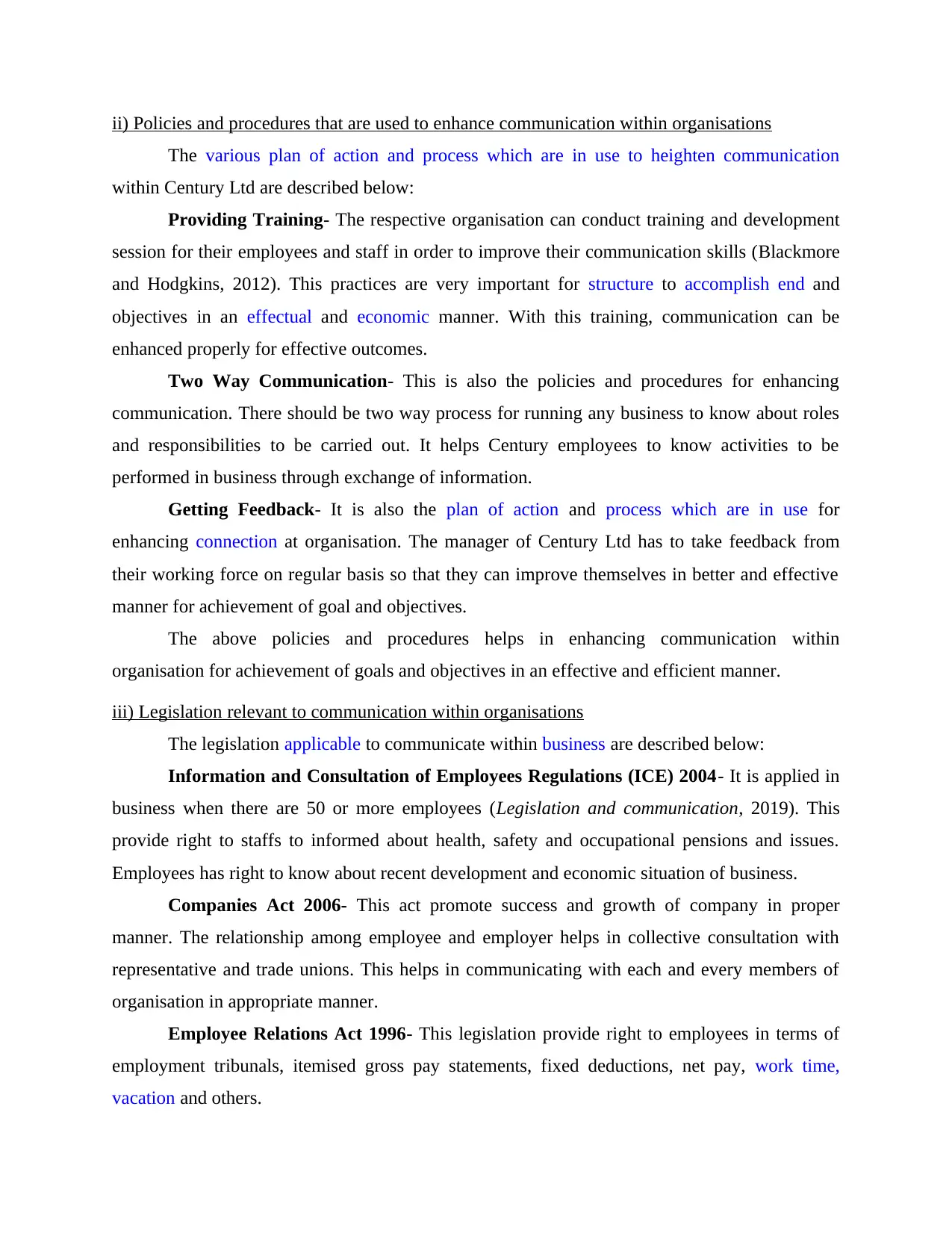
ii) Policies and procedures that are used to enhance communication within organisations
The various plan of action and process which are in use to heighten communication
within Century Ltd are described below:
Providing Training- The respective organisation can conduct training and development
session for their employees and staff in order to improve their communication skills (Blackmore
and Hodgkins, 2012). This practices are very important for structure to accomplish end and
objectives in an effectual and economic manner. With this training, communication can be
enhanced properly for effective outcomes.
Two Way Communication- This is also the policies and procedures for enhancing
communication. There should be two way process for running any business to know about roles
and responsibilities to be carried out. It helps Century employees to know activities to be
performed in business through exchange of information.
Getting Feedback- It is also the plan of action and process which are in use for
enhancing connection at organisation. The manager of Century Ltd has to take feedback from
their working force on regular basis so that they can improve themselves in better and effective
manner for achievement of goal and objectives.
The above policies and procedures helps in enhancing communication within
organisation for achievement of goals and objectives in an effective and efficient manner.
iii) Legislation relevant to communication within organisations
The legislation applicable to communicate within business are described below:
Information and Consultation of Employees Regulations (ICE) 2004- It is applied in
business when there are 50 or more employees (Legislation and communication, 2019). This
provide right to staffs to informed about health, safety and occupational pensions and issues.
Employees has right to know about recent development and economic situation of business.
Companies Act 2006- This act promote success and growth of company in proper
manner. The relationship among employee and employer helps in collective consultation with
representative and trade unions. This helps in communicating with each and every members of
organisation in appropriate manner.
Employee Relations Act 1996- This legislation provide right to employees in terms of
employment tribunals, itemised gross pay statements, fixed deductions, net pay, work time,
vacation and others.
The various plan of action and process which are in use to heighten communication
within Century Ltd are described below:
Providing Training- The respective organisation can conduct training and development
session for their employees and staff in order to improve their communication skills (Blackmore
and Hodgkins, 2012). This practices are very important for structure to accomplish end and
objectives in an effectual and economic manner. With this training, communication can be
enhanced properly for effective outcomes.
Two Way Communication- This is also the policies and procedures for enhancing
communication. There should be two way process for running any business to know about roles
and responsibilities to be carried out. It helps Century employees to know activities to be
performed in business through exchange of information.
Getting Feedback- It is also the plan of action and process which are in use for
enhancing connection at organisation. The manager of Century Ltd has to take feedback from
their working force on regular basis so that they can improve themselves in better and effective
manner for achievement of goal and objectives.
The above policies and procedures helps in enhancing communication within
organisation for achievement of goals and objectives in an effective and efficient manner.
iii) Legislation relevant to communication within organisations
The legislation applicable to communicate within business are described below:
Information and Consultation of Employees Regulations (ICE) 2004- It is applied in
business when there are 50 or more employees (Legislation and communication, 2019). This
provide right to staffs to informed about health, safety and occupational pensions and issues.
Employees has right to know about recent development and economic situation of business.
Companies Act 2006- This act promote success and growth of company in proper
manner. The relationship among employee and employer helps in collective consultation with
representative and trade unions. This helps in communicating with each and every members of
organisation in appropriate manner.
Employee Relations Act 1996- This legislation provide right to employees in terms of
employment tribunals, itemised gross pay statements, fixed deductions, net pay, work time,
vacation and others.
Paraphrase This Document
Need a fresh take? Get an instant paraphrase of this document with our AI Paraphraser
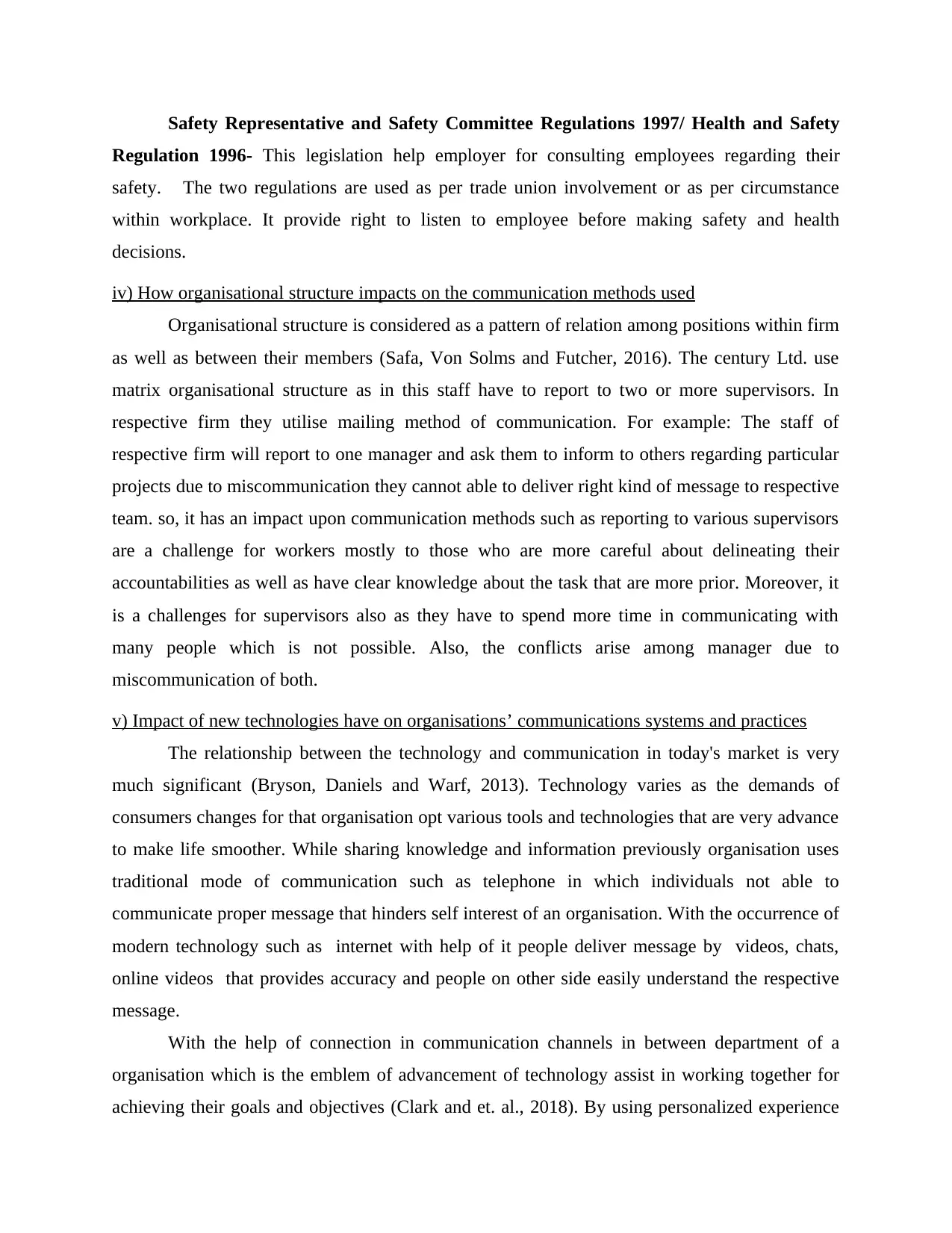
Safety Representative and Safety Committee Regulations 1997/ Health and Safety
Regulation 1996- This legislation help employer for consulting employees regarding their
safety. The two regulations are used as per trade union involvement or as per circumstance
within workplace. It provide right to listen to employee before making safety and health
decisions.
iv) How organisational structure impacts on the communication methods used
Organisational structure is considered as a pattern of relation among positions within firm
as well as between their members (Safa, Von Solms and Futcher, 2016). The century Ltd. use
matrix organisational structure as in this staff have to report to two or more supervisors. In
respective firm they utilise mailing method of communication. For example: The staff of
respective firm will report to one manager and ask them to inform to others regarding particular
projects due to miscommunication they cannot able to deliver right kind of message to respective
team. so, it has an impact upon communication methods such as reporting to various supervisors
are a challenge for workers mostly to those who are more careful about delineating their
accountabilities as well as have clear knowledge about the task that are more prior. Moreover, it
is a challenges for supervisors also as they have to spend more time in communicating with
many people which is not possible. Also, the conflicts arise among manager due to
miscommunication of both.
v) Impact of new technologies have on organisations’ communications systems and practices
The relationship between the technology and communication in today's market is very
much significant (Bryson, Daniels and Warf, 2013). Technology varies as the demands of
consumers changes for that organisation opt various tools and technologies that are very advance
to make life smoother. While sharing knowledge and information previously organisation uses
traditional mode of communication such as telephone in which individuals not able to
communicate proper message that hinders self interest of an organisation. With the occurrence of
modern technology such as internet with help of it people deliver message by videos, chats,
online videos that provides accuracy and people on other side easily understand the respective
message.
With the help of connection in communication channels in between department of a
organisation which is the emblem of advancement of technology assist in working together for
achieving their goals and objectives (Clark and et. al., 2018). By using personalized experience
Regulation 1996- This legislation help employer for consulting employees regarding their
safety. The two regulations are used as per trade union involvement or as per circumstance
within workplace. It provide right to listen to employee before making safety and health
decisions.
iv) How organisational structure impacts on the communication methods used
Organisational structure is considered as a pattern of relation among positions within firm
as well as between their members (Safa, Von Solms and Futcher, 2016). The century Ltd. use
matrix organisational structure as in this staff have to report to two or more supervisors. In
respective firm they utilise mailing method of communication. For example: The staff of
respective firm will report to one manager and ask them to inform to others regarding particular
projects due to miscommunication they cannot able to deliver right kind of message to respective
team. so, it has an impact upon communication methods such as reporting to various supervisors
are a challenge for workers mostly to those who are more careful about delineating their
accountabilities as well as have clear knowledge about the task that are more prior. Moreover, it
is a challenges for supervisors also as they have to spend more time in communicating with
many people which is not possible. Also, the conflicts arise among manager due to
miscommunication of both.
v) Impact of new technologies have on organisations’ communications systems and practices
The relationship between the technology and communication in today's market is very
much significant (Bryson, Daniels and Warf, 2013). Technology varies as the demands of
consumers changes for that organisation opt various tools and technologies that are very advance
to make life smoother. While sharing knowledge and information previously organisation uses
traditional mode of communication such as telephone in which individuals not able to
communicate proper message that hinders self interest of an organisation. With the occurrence of
modern technology such as internet with help of it people deliver message by videos, chats,
online videos that provides accuracy and people on other side easily understand the respective
message.
With the help of connection in communication channels in between department of a
organisation which is the emblem of advancement of technology assist in working together for
achieving their goals and objectives (Clark and et. al., 2018). By using personalized experience

century Ltd. can easily communicate regarding their products and services and features that
create difference from competitors product. The another example of advance technology,
robotics with help of them organisation can commence operations easily that are very
hazardous activity for human being which is one of best way to communicate and deliver
potential results to stakeholders.
SECTION B
I) Benefits of teamwork to both individuals and to organisations
Teamwork is applied in all organisation and business for achievement of better results.
This provide benefits to both single and to business which are described below:
Benefits to Individuals
Improves Morale- Teamwork helps in improving morale of individual for better work
performance (Colgan and McKearney, 2012). It helps in providing job satisfaction to individual
with feeling of joy which comes from belonging. As workload is easily shared among each other
that collaborates for achievement of work.
Improves Communication Skills- Teamwork help each and every individual to improve
communication skills. As each of them are assigned with their roles and responsibilities in order
to carry out work in proper manner which assist in improvement of communication skills.
Increases Skills and Knowledge- There are various members in team who possess
different skills and knowledge that assist individual to improve themselves. Working in team
assist in better results due to mixing of all skill, knowledge and others.
Benefits to Organisations
Productivity Boost- When work is divided equally among team members and allocated
as per knowledge, skills, capability then it helps in achieving results along with boosting
productivity for organisation.
Flexibility- If respective organisation provide flexibility to their working members then
they can work in effective and efficient manner for achievement of goal and objectives. This
helps in increasing productivity and profitability.
ii) Why teams might fail to meet their objectives
In order to work in team, there should be proper coordination, team building so that set
target can be achieved (Craig and Campbell, 2012). If team lack such then they does not achieve
create difference from competitors product. The another example of advance technology,
robotics with help of them organisation can commence operations easily that are very
hazardous activity for human being which is one of best way to communicate and deliver
potential results to stakeholders.
SECTION B
I) Benefits of teamwork to both individuals and to organisations
Teamwork is applied in all organisation and business for achievement of better results.
This provide benefits to both single and to business which are described below:
Benefits to Individuals
Improves Morale- Teamwork helps in improving morale of individual for better work
performance (Colgan and McKearney, 2012). It helps in providing job satisfaction to individual
with feeling of joy which comes from belonging. As workload is easily shared among each other
that collaborates for achievement of work.
Improves Communication Skills- Teamwork help each and every individual to improve
communication skills. As each of them are assigned with their roles and responsibilities in order
to carry out work in proper manner which assist in improvement of communication skills.
Increases Skills and Knowledge- There are various members in team who possess
different skills and knowledge that assist individual to improve themselves. Working in team
assist in better results due to mixing of all skill, knowledge and others.
Benefits to Organisations
Productivity Boost- When work is divided equally among team members and allocated
as per knowledge, skills, capability then it helps in achieving results along with boosting
productivity for organisation.
Flexibility- If respective organisation provide flexibility to their working members then
they can work in effective and efficient manner for achievement of goal and objectives. This
helps in increasing productivity and profitability.
ii) Why teams might fail to meet their objectives
In order to work in team, there should be proper coordination, team building so that set
target can be achieved (Craig and Campbell, 2012). If team lack such then they does not achieve
⊘ This is a preview!⊘
Do you want full access?
Subscribe today to unlock all pages.

Trusted by 1+ million students worldwide
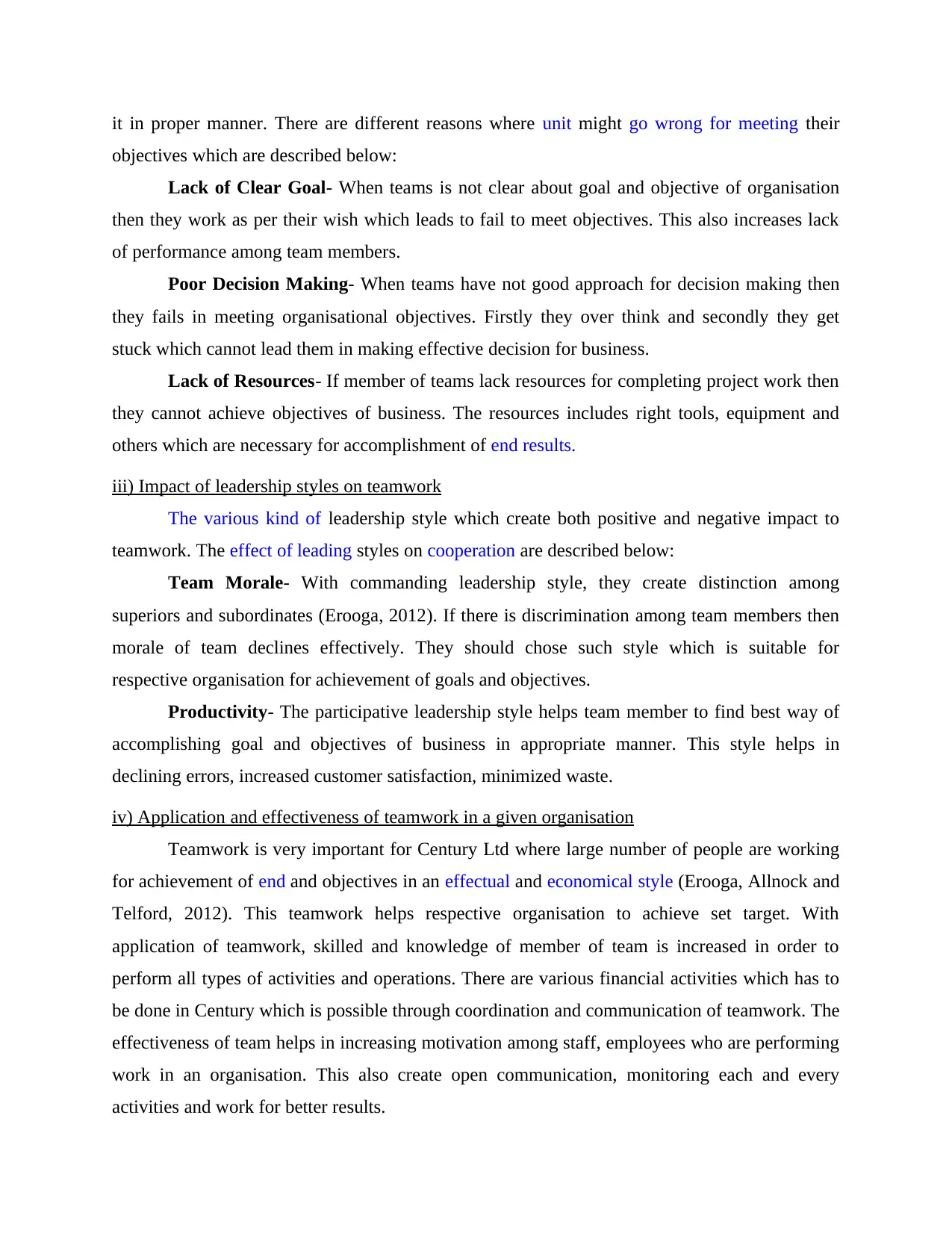
it in proper manner. There are different reasons where unit might go wrong for meeting their
objectives which are described below:
Lack of Clear Goal- When teams is not clear about goal and objective of organisation
then they work as per their wish which leads to fail to meet objectives. This also increases lack
of performance among team members.
Poor Decision Making- When teams have not good approach for decision making then
they fails in meeting organisational objectives. Firstly they over think and secondly they get
stuck which cannot lead them in making effective decision for business.
Lack of Resources- If member of teams lack resources for completing project work then
they cannot achieve objectives of business. The resources includes right tools, equipment and
others which are necessary for accomplishment of end results.
iii) Impact of leadership styles on teamwork
The various kind of leadership style which create both positive and negative impact to
teamwork. The effect of leading styles on cooperation are described below:
Team Morale- With commanding leadership style, they create distinction among
superiors and subordinates (Erooga, 2012). If there is discrimination among team members then
morale of team declines effectively. They should chose such style which is suitable for
respective organisation for achievement of goals and objectives.
Productivity- The participative leadership style helps team member to find best way of
accomplishing goal and objectives of business in appropriate manner. This style helps in
declining errors, increased customer satisfaction, minimized waste.
iv) Application and effectiveness of teamwork in a given organisation
Teamwork is very important for Century Ltd where large number of people are working
for achievement of end and objectives in an effectual and economical style (Erooga, Allnock and
Telford, 2012). This teamwork helps respective organisation to achieve set target. With
application of teamwork, skilled and knowledge of member of team is increased in order to
perform all types of activities and operations. There are various financial activities which has to
be done in Century which is possible through coordination and communication of teamwork. The
effectiveness of team helps in increasing motivation among staff, employees who are performing
work in an organisation. This also create open communication, monitoring each and every
activities and work for better results.
objectives which are described below:
Lack of Clear Goal- When teams is not clear about goal and objective of organisation
then they work as per their wish which leads to fail to meet objectives. This also increases lack
of performance among team members.
Poor Decision Making- When teams have not good approach for decision making then
they fails in meeting organisational objectives. Firstly they over think and secondly they get
stuck which cannot lead them in making effective decision for business.
Lack of Resources- If member of teams lack resources for completing project work then
they cannot achieve objectives of business. The resources includes right tools, equipment and
others which are necessary for accomplishment of end results.
iii) Impact of leadership styles on teamwork
The various kind of leadership style which create both positive and negative impact to
teamwork. The effect of leading styles on cooperation are described below:
Team Morale- With commanding leadership style, they create distinction among
superiors and subordinates (Erooga, 2012). If there is discrimination among team members then
morale of team declines effectively. They should chose such style which is suitable for
respective organisation for achievement of goals and objectives.
Productivity- The participative leadership style helps team member to find best way of
accomplishing goal and objectives of business in appropriate manner. This style helps in
declining errors, increased customer satisfaction, minimized waste.
iv) Application and effectiveness of teamwork in a given organisation
Teamwork is very important for Century Ltd where large number of people are working
for achievement of end and objectives in an effectual and economical style (Erooga, Allnock and
Telford, 2012). This teamwork helps respective organisation to achieve set target. With
application of teamwork, skilled and knowledge of member of team is increased in order to
perform all types of activities and operations. There are various financial activities which has to
be done in Century which is possible through coordination and communication of teamwork. The
effectiveness of team helps in increasing motivation among staff, employees who are performing
work in an organisation. This also create open communication, monitoring each and every
activities and work for better results.
Paraphrase This Document
Need a fresh take? Get an instant paraphrase of this document with our AI Paraphraser
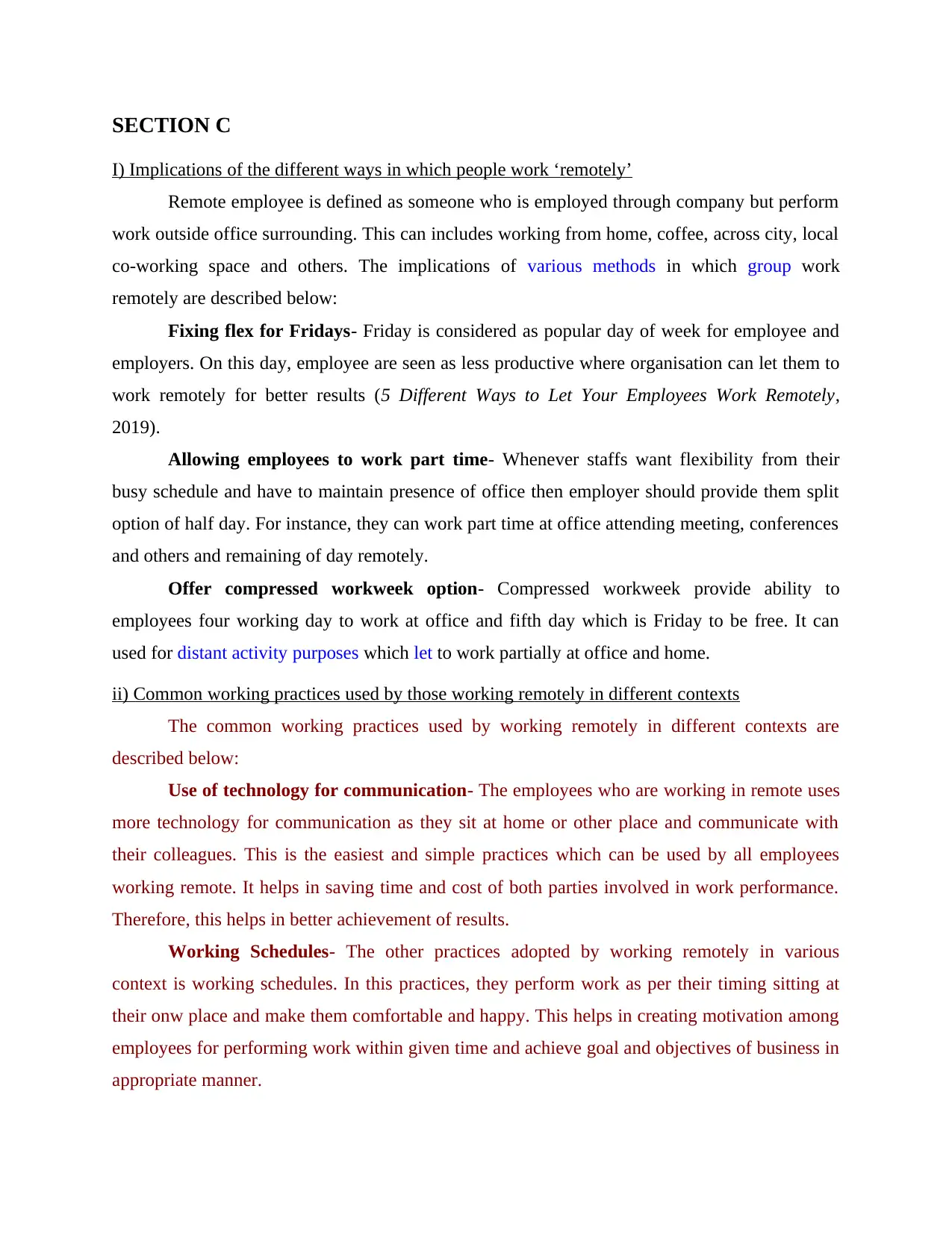
SECTION C
I) Implications of the different ways in which people work ‘remotely’
Remote employee is defined as someone who is employed through company but perform
work outside office surrounding. This can includes working from home, coffee, across city, local
co-working space and others. The implications of various methods in which group work
remotely are described below:
Fixing flex for Fridays- Friday is considered as popular day of week for employee and
employers. On this day, employee are seen as less productive where organisation can let them to
work remotely for better results (5 Different Ways to Let Your Employees Work Remotely,
2019).
Allowing employees to work part time- Whenever staffs want flexibility from their
busy schedule and have to maintain presence of office then employer should provide them split
option of half day. For instance, they can work part time at office attending meeting, conferences
and others and remaining of day remotely.
Offer compressed workweek option- Compressed workweek provide ability to
employees four working day to work at office and fifth day which is Friday to be free. It can
used for distant activity purposes which let to work partially at office and home.
ii) Common working practices used by those working remotely in different contexts
The common working practices used by working remotely in different contexts are
described below:
Use of technology for communication- The employees who are working in remote uses
more technology for communication as they sit at home or other place and communicate with
their colleagues. This is the easiest and simple practices which can be used by all employees
working remote. It helps in saving time and cost of both parties involved in work performance.
Therefore, this helps in better achievement of results.
Working Schedules- The other practices adopted by working remotely in various
context is working schedules. In this practices, they perform work as per their timing sitting at
their onw place and make them comfortable and happy. This helps in creating motivation among
employees for performing work within given time and achieve goal and objectives of business in
appropriate manner.
I) Implications of the different ways in which people work ‘remotely’
Remote employee is defined as someone who is employed through company but perform
work outside office surrounding. This can includes working from home, coffee, across city, local
co-working space and others. The implications of various methods in which group work
remotely are described below:
Fixing flex for Fridays- Friday is considered as popular day of week for employee and
employers. On this day, employee are seen as less productive where organisation can let them to
work remotely for better results (5 Different Ways to Let Your Employees Work Remotely,
2019).
Allowing employees to work part time- Whenever staffs want flexibility from their
busy schedule and have to maintain presence of office then employer should provide them split
option of half day. For instance, they can work part time at office attending meeting, conferences
and others and remaining of day remotely.
Offer compressed workweek option- Compressed workweek provide ability to
employees four working day to work at office and fifth day which is Friday to be free. It can
used for distant activity purposes which let to work partially at office and home.
ii) Common working practices used by those working remotely in different contexts
The common working practices used by working remotely in different contexts are
described below:
Use of technology for communication- The employees who are working in remote uses
more technology for communication as they sit at home or other place and communicate with
their colleagues. This is the easiest and simple practices which can be used by all employees
working remote. It helps in saving time and cost of both parties involved in work performance.
Therefore, this helps in better achievement of results.
Working Schedules- The other practices adopted by working remotely in various
context is working schedules. In this practices, they perform work as per their timing sitting at
their onw place and make them comfortable and happy. This helps in creating motivation among
employees for performing work within given time and achieve goal and objectives of business in
appropriate manner.

iii) Leadership styles appropriate for remote working
The various leadership styles which are suitable for distant working are described below:
Laissez-Faire Style- When team is strong, then such style can work effectively in
remotely (Types of Leadership for Remote Teams, 2017). It is very important for organisation to
trust remote workers for work performance. This also helps in distributing work to each and
every team members and calculating progress in proper manner. When employees is in office or
working remotely then they don't rely on trust rather than that they should follow work.
Transactional Style- This style is best suitable while working in an remotely as it is
effective and efficient in nature. When organisation knows what has to be done from team then
transactional leadership can work well for remote team. This style work when each and every
aspect is cleared to organisation.
Transformational Style- The remote worker always focus on doing things differently.
This helps in making them average, responsive and visioner for performing work in effective and
efficient manner. Remote team focus on making extra efforts for maintaining member's
commitment to vision.
SECTION D
I) How Human Resource departments can provide support and monitor people within workplace
Human resource departments are those which focus on selecting skilled, capable and
experience person for organisation. With help of such departments, they can easily supply assist
and show people within workplace.
Training and Development- HR department provide support and monitor people by
providing them training and development which assist them to improve themselves for better
outcome (Johansson and Lee, 2014). It is provided on regular basis for achieving maximum gain
and profits.
Motivation- The people working in organisation should be motivated for better work
performance along with encouraging them to give their best so that maximum output can be
achieved without any problems.
Feedback- It is the most important for HR department to take and provide feedback to
people in order to monitor and support them. It helps both to improve themselves for
achievement of score and end results in an impressive and prompt mode.
The various leadership styles which are suitable for distant working are described below:
Laissez-Faire Style- When team is strong, then such style can work effectively in
remotely (Types of Leadership for Remote Teams, 2017). It is very important for organisation to
trust remote workers for work performance. This also helps in distributing work to each and
every team members and calculating progress in proper manner. When employees is in office or
working remotely then they don't rely on trust rather than that they should follow work.
Transactional Style- This style is best suitable while working in an remotely as it is
effective and efficient in nature. When organisation knows what has to be done from team then
transactional leadership can work well for remote team. This style work when each and every
aspect is cleared to organisation.
Transformational Style- The remote worker always focus on doing things differently.
This helps in making them average, responsive and visioner for performing work in effective and
efficient manner. Remote team focus on making extra efforts for maintaining member's
commitment to vision.
SECTION D
I) How Human Resource departments can provide support and monitor people within workplace
Human resource departments are those which focus on selecting skilled, capable and
experience person for organisation. With help of such departments, they can easily supply assist
and show people within workplace.
Training and Development- HR department provide support and monitor people by
providing them training and development which assist them to improve themselves for better
outcome (Johansson and Lee, 2014). It is provided on regular basis for achieving maximum gain
and profits.
Motivation- The people working in organisation should be motivated for better work
performance along with encouraging them to give their best so that maximum output can be
achieved without any problems.
Feedback- It is the most important for HR department to take and provide feedback to
people in order to monitor and support them. It helps both to improve themselves for
achievement of score and end results in an impressive and prompt mode.
⊘ This is a preview!⊘
Do you want full access?
Subscribe today to unlock all pages.

Trusted by 1+ million students worldwide
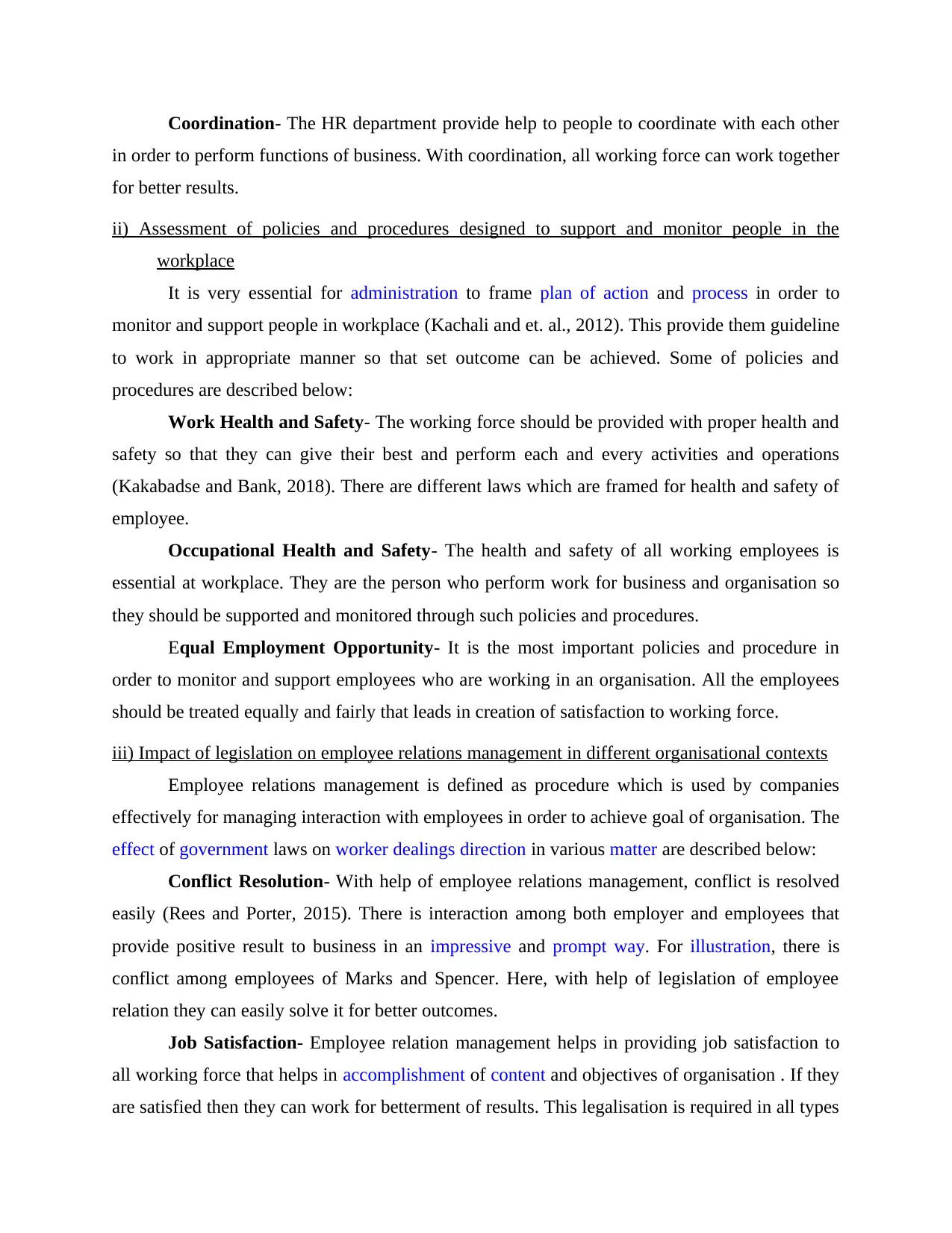
Coordination- The HR department provide help to people to coordinate with each other
in order to perform functions of business. With coordination, all working force can work together
for better results.
ii) Assessment of policies and procedures designed to support and monitor people in the
workplace
It is very essential for administration to frame plan of action and process in order to
monitor and support people in workplace (Kachali and et. al., 2012). This provide them guideline
to work in appropriate manner so that set outcome can be achieved. Some of policies and
procedures are described below:
Work Health and Safety- The working force should be provided with proper health and
safety so that they can give their best and perform each and every activities and operations
(Kakabadse and Bank, 2018). There are different laws which are framed for health and safety of
employee.
Occupational Health and Safety- The health and safety of all working employees is
essential at workplace. They are the person who perform work for business and organisation so
they should be supported and monitored through such policies and procedures.
Equal Employment Opportunity- It is the most important policies and procedure in
order to monitor and support employees who are working in an organisation. All the employees
should be treated equally and fairly that leads in creation of satisfaction to working force.
iii) Impact of legislation on employee relations management in different organisational contexts
Employee relations management is defined as procedure which is used by companies
effectively for managing interaction with employees in order to achieve goal of organisation. The
effect of government laws on worker dealings direction in various matter are described below:
Conflict Resolution- With help of employee relations management, conflict is resolved
easily (Rees and Porter, 2015). There is interaction among both employer and employees that
provide positive result to business in an impressive and prompt way. For illustration, there is
conflict among employees of Marks and Spencer. Here, with help of legislation of employee
relation they can easily solve it for better outcomes.
Job Satisfaction- Employee relation management helps in providing job satisfaction to
all working force that helps in accomplishment of content and objectives of organisation . If they
are satisfied then they can work for betterment of results. This legalisation is required in all types
in order to perform functions of business. With coordination, all working force can work together
for better results.
ii) Assessment of policies and procedures designed to support and monitor people in the
workplace
It is very essential for administration to frame plan of action and process in order to
monitor and support people in workplace (Kachali and et. al., 2012). This provide them guideline
to work in appropriate manner so that set outcome can be achieved. Some of policies and
procedures are described below:
Work Health and Safety- The working force should be provided with proper health and
safety so that they can give their best and perform each and every activities and operations
(Kakabadse and Bank, 2018). There are different laws which are framed for health and safety of
employee.
Occupational Health and Safety- The health and safety of all working employees is
essential at workplace. They are the person who perform work for business and organisation so
they should be supported and monitored through such policies and procedures.
Equal Employment Opportunity- It is the most important policies and procedure in
order to monitor and support employees who are working in an organisation. All the employees
should be treated equally and fairly that leads in creation of satisfaction to working force.
iii) Impact of legislation on employee relations management in different organisational contexts
Employee relations management is defined as procedure which is used by companies
effectively for managing interaction with employees in order to achieve goal of organisation. The
effect of government laws on worker dealings direction in various matter are described below:
Conflict Resolution- With help of employee relations management, conflict is resolved
easily (Rees and Porter, 2015). There is interaction among both employer and employees that
provide positive result to business in an impressive and prompt way. For illustration, there is
conflict among employees of Marks and Spencer. Here, with help of legislation of employee
relation they can easily solve it for better outcomes.
Job Satisfaction- Employee relation management helps in providing job satisfaction to
all working force that helps in accomplishment of content and objectives of organisation . If they
are satisfied then they can work for betterment of results. This legalisation is required in all types
Paraphrase This Document
Need a fresh take? Get an instant paraphrase of this document with our AI Paraphraser

of organisation for effective results. For example, there are two organisation where employees
are working out of which one employee is high satisfied with job and another is not happy and
unsatisfied with jobs. In this case, happy employee achieve business objectives and unhappy
leads to decline productivity.
Motivation- For achievement of business objectives, employee should be motivated by
providing benefits in terms of perks, incentives, bonus and so on. The employee relations
management legislation provide support to each and every employees for positive outcomes.
CONCLUSION
From the preceding written report, it has been concluded that administration has to
manage their people for achievement of goal and objectives in proper manner. There are
different communication practices which has to be followed by business for better outcomes. The
different policies, procedures, legislation are framed for enhancement of communication within
organisation. Teamwork is essential for carrying complex and difficult project which helps to
provide benefits to organisation and individuals. Due to lack of coordination, poor decision
making leads to fail to meet objectives of business. Leadership style has impacted on teamwork
of enterprise. Remote working also helps in better result for organisation as it provide freedom to
perform work as per their own requirements. Human resource departments also helps in
providing support and monitor people at workplace through providing them job satisfaction,
motivation and many more.
are working out of which one employee is high satisfied with job and another is not happy and
unsatisfied with jobs. In this case, happy employee achieve business objectives and unhappy
leads to decline productivity.
Motivation- For achievement of business objectives, employee should be motivated by
providing benefits in terms of perks, incentives, bonus and so on. The employee relations
management legislation provide support to each and every employees for positive outcomes.
CONCLUSION
From the preceding written report, it has been concluded that administration has to
manage their people for achievement of goal and objectives in proper manner. There are
different communication practices which has to be followed by business for better outcomes. The
different policies, procedures, legislation are framed for enhancement of communication within
organisation. Teamwork is essential for carrying complex and difficult project which helps to
provide benefits to organisation and individuals. Due to lack of coordination, poor decision
making leads to fail to meet objectives of business. Leadership style has impacted on teamwork
of enterprise. Remote working also helps in better result for organisation as it provide freedom to
perform work as per their own requirements. Human resource departments also helps in
providing support and monitor people at workplace through providing them job satisfaction,
motivation and many more.
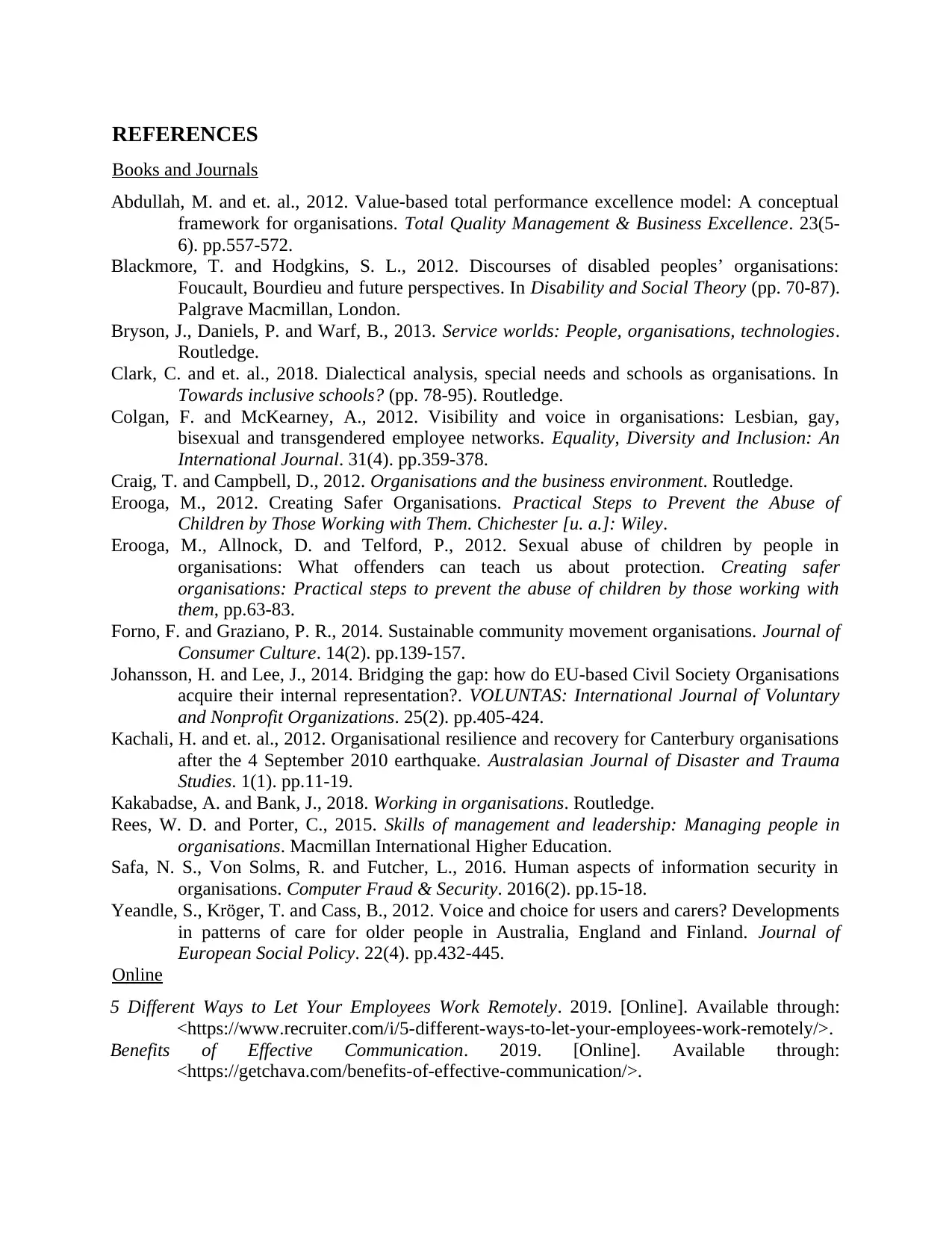
REFERENCES
Books and Journals
Abdullah, M. and et. al., 2012. Value-based total performance excellence model: A conceptual
framework for organisations. Total Quality Management & Business Excellence. 23(5-
6). pp.557-572.
Blackmore, T. and Hodgkins, S. L., 2012. Discourses of disabled peoples’ organisations:
Foucault, Bourdieu and future perspectives. In Disability and Social Theory (pp. 70-87).
Palgrave Macmillan, London.
Bryson, J., Daniels, P. and Warf, B., 2013. Service worlds: People, organisations, technologies.
Routledge.
Clark, C. and et. al., 2018. Dialectical analysis, special needs and schools as organisations. In
Towards inclusive schools? (pp. 78-95). Routledge.
Colgan, F. and McKearney, A., 2012. Visibility and voice in organisations: Lesbian, gay,
bisexual and transgendered employee networks. Equality, Diversity and Inclusion: An
International Journal. 31(4). pp.359-378.
Craig, T. and Campbell, D., 2012. Organisations and the business environment. Routledge.
Erooga, M., 2012. Creating Safer Organisations. Practical Steps to Prevent the Abuse of
Children by Those Working with Them. Chichester [u. a.]: Wiley.
Erooga, M., Allnock, D. and Telford, P., 2012. Sexual abuse of children by people in
organisations: What offenders can teach us about protection. Creating safer
organisations: Practical steps to prevent the abuse of children by those working with
them, pp.63-83.
Forno, F. and Graziano, P. R., 2014. Sustainable community movement organisations. Journal of
Consumer Culture. 14(2). pp.139-157.
Johansson, H. and Lee, J., 2014. Bridging the gap: how do EU-based Civil Society Organisations
acquire their internal representation?. VOLUNTAS: International Journal of Voluntary
and Nonprofit Organizations. 25(2). pp.405-424.
Kachali, H. and et. al., 2012. Organisational resilience and recovery for Canterbury organisations
after the 4 September 2010 earthquake. Australasian Journal of Disaster and Trauma
Studies. 1(1). pp.11-19.
Kakabadse, A. and Bank, J., 2018. Working in organisations. Routledge.
Rees, W. D. and Porter, C., 2015. Skills of management and leadership: Managing people in
organisations. Macmillan International Higher Education.
Safa, N. S., Von Solms, R. and Futcher, L., 2016. Human aspects of information security in
organisations. Computer Fraud & Security. 2016(2). pp.15-18.
Yeandle, S., Kröger, T. and Cass, B., 2012. Voice and choice for users and carers? Developments
in patterns of care for older people in Australia, England and Finland. Journal of
European Social Policy. 22(4). pp.432-445.
Online
5 Different Ways to Let Your Employees Work Remotely. 2019. [Online]. Available through:
<https://www.recruiter.com/i/5-different-ways-to-let-your-employees-work-remotely/>.
Benefits of Effective Communication. 2019. [Online]. Available through:
<https://getchava.com/benefits-of-effective-communication/>.
Books and Journals
Abdullah, M. and et. al., 2012. Value-based total performance excellence model: A conceptual
framework for organisations. Total Quality Management & Business Excellence. 23(5-
6). pp.557-572.
Blackmore, T. and Hodgkins, S. L., 2012. Discourses of disabled peoples’ organisations:
Foucault, Bourdieu and future perspectives. In Disability and Social Theory (pp. 70-87).
Palgrave Macmillan, London.
Bryson, J., Daniels, P. and Warf, B., 2013. Service worlds: People, organisations, technologies.
Routledge.
Clark, C. and et. al., 2018. Dialectical analysis, special needs and schools as organisations. In
Towards inclusive schools? (pp. 78-95). Routledge.
Colgan, F. and McKearney, A., 2012. Visibility and voice in organisations: Lesbian, gay,
bisexual and transgendered employee networks. Equality, Diversity and Inclusion: An
International Journal. 31(4). pp.359-378.
Craig, T. and Campbell, D., 2012. Organisations and the business environment. Routledge.
Erooga, M., 2012. Creating Safer Organisations. Practical Steps to Prevent the Abuse of
Children by Those Working with Them. Chichester [u. a.]: Wiley.
Erooga, M., Allnock, D. and Telford, P., 2012. Sexual abuse of children by people in
organisations: What offenders can teach us about protection. Creating safer
organisations: Practical steps to prevent the abuse of children by those working with
them, pp.63-83.
Forno, F. and Graziano, P. R., 2014. Sustainable community movement organisations. Journal of
Consumer Culture. 14(2). pp.139-157.
Johansson, H. and Lee, J., 2014. Bridging the gap: how do EU-based Civil Society Organisations
acquire their internal representation?. VOLUNTAS: International Journal of Voluntary
and Nonprofit Organizations. 25(2). pp.405-424.
Kachali, H. and et. al., 2012. Organisational resilience and recovery for Canterbury organisations
after the 4 September 2010 earthquake. Australasian Journal of Disaster and Trauma
Studies. 1(1). pp.11-19.
Kakabadse, A. and Bank, J., 2018. Working in organisations. Routledge.
Rees, W. D. and Porter, C., 2015. Skills of management and leadership: Managing people in
organisations. Macmillan International Higher Education.
Safa, N. S., Von Solms, R. and Futcher, L., 2016. Human aspects of information security in
organisations. Computer Fraud & Security. 2016(2). pp.15-18.
Yeandle, S., Kröger, T. and Cass, B., 2012. Voice and choice for users and carers? Developments
in patterns of care for older people in Australia, England and Finland. Journal of
European Social Policy. 22(4). pp.432-445.
Online
5 Different Ways to Let Your Employees Work Remotely. 2019. [Online]. Available through:
<https://www.recruiter.com/i/5-different-ways-to-let-your-employees-work-remotely/>.
Benefits of Effective Communication. 2019. [Online]. Available through:
<https://getchava.com/benefits-of-effective-communication/>.
⊘ This is a preview!⊘
Do you want full access?
Subscribe today to unlock all pages.

Trusted by 1+ million students worldwide
1 out of 13
Related Documents
Your All-in-One AI-Powered Toolkit for Academic Success.
+13062052269
info@desklib.com
Available 24*7 on WhatsApp / Email
![[object Object]](/_next/static/media/star-bottom.7253800d.svg)
Unlock your academic potential
Copyright © 2020–2025 A2Z Services. All Rights Reserved. Developed and managed by ZUCOL.



